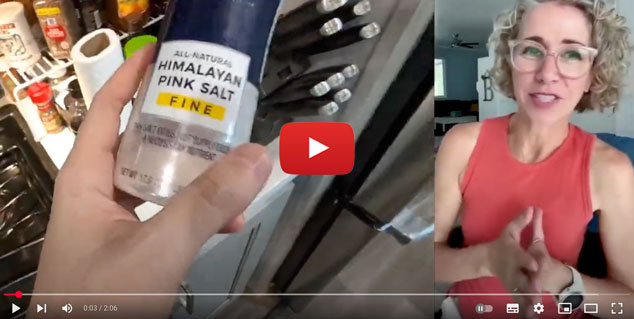Japanese Pink Salt Diet: Natural Weight Loss & Wellness Guide
The Japanese Pink Salt Diet: A Natural Approach to Weight Loss
In the ever-evolving landscape of health and wellness, the quest for effective and sustainable weight loss solutions remains a top priority for many.
Among the myriad of dietary trends, the Japanese Pink Salt Diet has emerged as a natural and holistic approach that combines ancient traditions with modern nutritional insights.
This diet centers around the use of Himalayan pink salt, renowned for its rich mineral content and potential health benefits.
Understanding the Japanese Pink Salt Diet
The Japanese Pink Salt Diet is not a conventional diet plan but rather a wellness ritual that incorporates Himalayan pink salt into daily routines.
This approach is inspired by traditional Japanese practices that emphasize balance, mindfulness, and the healing properties of natural ingredients.
What is Himalayan Pink Salt?
Himalayan pink salt is a type of rock salt harvested from the Khewra Salt Mine in Pakistan, near the Himalayas.
Its distinctive pink hue is due to trace minerals such as iron, magnesium, calcium, and potassium.
Unlike regular table salt, which is heavily processed and stripped of its natural minerals, Himalayan pink salt is minimally processed, retaining its natural mineral profile.
Health Benefits of the Japanese Pink Salt Diet
The Japanese Pink Salt Diet is lauded for its potential to support various aspects of health, particularly in the context of weight management. Here are some of the key benefits associated with this dietary approach:
1. Supports Metabolic Function
Himalayan pink salt contains minerals that are essential for metabolic processes. By providing these minerals, the diet may help enhance metabolic efficiency.
For instance, magnesium plays a crucial role in energy production and enzyme function, while iron is vital for oxygen transport in the blood.
2. Aids in Digestion
Incorporating pink salt into the diet can stimulate the production of digestive enzymes and juices, facilitating better digestion and nutrient absorption.
Improved digestion can lead to reduced bloating and more efficient elimination of waste, contributing to overall digestive health.
3. Balances Electrolytes
Electrolyte balance is essential for maintaining hydration, nerve function, and muscle contractions.
The minerals in Himalayan pink salt, such as potassium and sodium, help maintain this balance, which is particularly beneficial during physical activity or in hot climates.
4. Reduces Cravings
Mineral deficiencies can sometimes manifest as food cravings.
By replenishing essential minerals, the Japanese Pink Salt Diet may help reduce unhealthy cravings, making it easier to adhere to a balanced diet.
5. Promotes Detoxification
The minerals in pink salt are believed to support the body’s natural detoxification processes.
By aiding in the removal of toxins and waste products, the diet may contribute to improved liver and kidney function.
The Pink Salt Trick: A Morning Ritual
A popular component of the Japanese Pink Salt Diet is the “Pink Salt Trick,” a morning ritual that involves consuming a warm beverage made with Himalayan pink salt, lemon juice, and water.
This practice is thought to kickstart metabolism, aid digestion, and promote hydration.
Pink Salt Trick Recipe
Ingredients:
- 1 glass of warm filtered water (8–12 oz)
- 1/4 teaspoon of finely ground Himalayan pink salt
- 1/2 teaspoon of fresh lemon juice
- 1 teaspoon of raw honey (optional)
Instructions:
- Pour warm filtered water into a glass.
- Add the Himalayan pink salt and stir until completely dissolved.
- Squeeze in the lemon juice and stir in honey if desired.
- Sip slowly, preferably on an empty stomach, to maximize benefits.
This simple concoction is easy to prepare and can be customized with additional ingredients like ginger or mint for added flavor and health benefits.
Scientific Perspective
While anecdotal evidence and traditional practices support the benefits of the Japanese Pink Salt Diet, scientific research provides a more nuanced view.
Mineral Content and Health Impact
- Studies have shown that Himalayan pink salt contains trace amounts of minerals not found in regular table salt. However, the quantities of these minerals are relatively small.
- For example, to meet the recommended daily intake of potassium solely from pink salt, one would need to consume an impractically large amount, which is not advisable due to sodium content.
Weight Loss and Detoxification
- There is limited scientific evidence directly linking pink salt consumption to significant weight loss or detoxification. The body’s primary detox organs, the liver and kidneys, effectively remove toxins without the need for special diets or supplements.
- Therefore, while the Pink Salt Trick may support hydration and provide a sense of well-being, it should not be relied upon as a sole method for weight loss or detoxification.
Integrating the Japanese Pink Salt Diet into a Healthy Lifestyle
For those interested in incorporating the Japanese Pink Salt Diet into their wellness routine, it’s important to do so as part of a balanced and holistic approach to health.
Tips for Success:
- Moderation is Key: While pink salt offers certain benefits, excessive salt intake can lead to health issues such as high blood pressure. Use it sparingly and mindfully.
- Stay Hydrated: Adequate water intake is essential for overall health and can enhance the benefits of the Pink Salt Trick.
- Balanced Diet: Complement the diet with a variety of nutrient-rich foods, including fruits, vegetables, whole grains, lean proteins, and healthy fats.
- Regular Exercise: Physical activity supports weight management and overall well-being.
- Consult Healthcare Providers: Before making significant changes to your diet, especially if you have underlying health conditions, consult with a healthcare professional.
How to Build a Meal Plan Around the Japanese Pink Salt Diet?
While the Pink Salt Trick is a cornerstone, a full meal plan inspired by the Japanese Pink Salt Diet incorporates nutritious foods that align with Japan’s culinary traditions and leverage the benefits of pink salt without overdoing it.
Sample Daily Meal Plan
Morning:
- Pink Salt Lemon Water (the Pink Salt Trick)
- Miso soup with tofu, wakame (seaweed), and chopped scallions
- Small bowl of steamed rice or fermented brown rice
Mid-Morning Snack:
- Edamame lightly sprinkled with Himalayan pink salt
- Green tea
Lunch:
- Grilled salmon or mackerel (seasoned with pink salt, lemon, and herbs)
- Steamed vegetables (broccoli, carrots, lotus root)
- Mixed greens salad with sesame dressing and a dash of pink salt
Afternoon Snack:
- Pickled vegetables or tsukemono
- A handful of roasted seaweed snacks
Dinner:
- Vegetable stir-fry with tofu and tamari (gluten-free soy sauce)
- Sweet potato or soba noodles
- Light miso soup with daikon and mushrooms
Before Bed:
- Herbal tea (like roasted barley or chamomile)
- Optional: A pinch of pink salt in warm water to support overnight hydration
This meal plan avoids processed foods, refined sugars, and excessive calories while reinforcing the benefits of mineral balance, fiber, and antioxidants.
How the Japanese Pink Salt Diet Compares to Other Salt-Based Diet Trends?
Vs. The Sole Water Trend
- Sole water a saturated solution of pink salt in water has become popular for its supposed health benefits.
- The Japanese Pink Salt Diet offers a more nuanced and food-integrated approach.
- Rather than sipping a salty tonic, it uses small doses of pink salt across meals and rituals in line with Japanese wellness philosophies.
Vs. Salt Fasts or Flushes
- Some extreme diets recommend “salt flushes” that involve drinking salt water to induce rapid bowel movements. These are often unsafe and dehydrating.
- The Japanese Pink Salt Diet takes a gentler, sustainable path focusing on restoring natural balance, not shocking the body.
Vs. Traditional Low-Sodium Diets
- Most Western diets overemphasize sodium through processed foods. A common reaction is to eliminate salt completely.
- However, the Japanese Pink Salt Diet acknowledges the need for natural, unprocessed salts to maintain electrolyte health showing that not all sodium is created equal.
FAQs About the Japanese Pink Salt Diet
Can I use pink salt for cooking instead of table salt?
- Absolutely. In fact, that’s one of the easiest ways to adopt this diet. Just keep portions small and remember it’s still sodium.
Is this diet vegan or gluten-free?
- Yes, it can be both. The core principles are flexible and work well with plant-based or gluten-free lifestyles.
How long before I see results?
- While everyone is different, many report noticeable digestive improvements within a week and gradual weight management benefits over several weeks, especially when combined with exercise and clean eating.
Is pink salt better than sea salt?
- Both have their place. Sea salt is typically harvested from evaporated seawater, while pink salt is mined from ancient salt deposits. Pink salt may have a slight edge in mineral diversity, but the difference is subtle.
Conclusion
If you’re looking for a no-gimmick, culturally-rooted, health-conscious way to improve your diet, the Japanese Pink Salt Diet offers real promise.
It’s not about cutting carbs, counting macros, or chasing quick fixes. Instead, it’s a daily practice small, mineral-rich, and rooted in balance.
This diet invites you to reconnect with your body, understand your cravings, and support your system with ingredients nature has already designed to nourish you.
It’s not a miracle, it’s a method. One that fits effortlessly into a lifestyle that values longevity, vitality, and simplicity.
In a world filled with complexity, the Japanese Pink Salt Diet might be the reminder we need: that sometimes, wellness begins with something as small and powerful as a pinch of salt.
.




